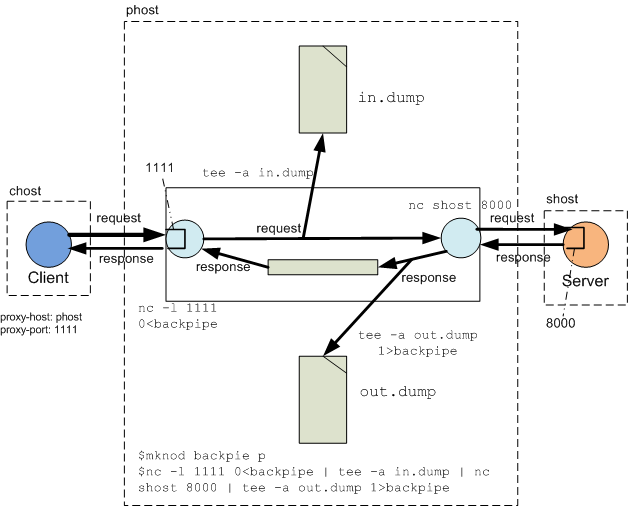There are times when you do want to see what bytes are flowing over wire in HTTP communication (or any TCP/IP communication). A good tool on Unix/Linux to use for this purpose is netcat (it is available as command nc), as long as you have the ability to set proxy host and post at the client side. This is best explained by the following diagram: 
Let us say your client program running on machine chost is talking to the Server program running on machine shost and listening for connections at port 8000. To capture the request and response traffic in files, you need to do two things: Setup a netcat based proxy either on a third machine phost or any of the client or server machines. The commands are shown in the above diagram (click to enlarge). The first command mknod backpipe p creates a FIFO. The next command nc -l 1111 0<backpipe | tee -a in.dump | nc shost 8000 | tee -a out.dump 1>backpipe does a number of things: (a) runs a netcat program that listens for incoming connections at port 1111, writes output to stdout and reads input from FIFO backpipe; (b) runs a tee program that write a copy of the previous netcat output to file in.dump; (c) runs a second netcat program that reads the output of the first netcat program, connects to the server program running on shost at port 8000 and forwards all data to the newly established connection. the response messages from this connection are written back to the stdout of this program; (d) runs a second tee program that sends the output of the second netcat program (ie; the response messages from the server program) to FIFO backpipe and also appends a copy to file out.dump. Data bytes written to FIFO backpipe are read by the first netcat program and returned to the client program as response message.
Specify the proxy host and port for the client. This can often be done without modifying the program. For example, most Browsers have GUI options to set proxy host and post; Java programs allow setting http.proxyHost and http.proxyPort system properties; and CURL based PHP programs have option CURLOPT_PROXY.
The request message gets captured in file in.dump and response message in out.dump on the machine where netcat based capturing proxy is running.Read more: Pankaj Kumar's Weblog

Let us say your client program running on machine chost is talking to the Server program running on machine shost and listening for connections at port 8000. To capture the request and response traffic in files, you need to do two things: Setup a netcat based proxy either on a third machine phost or any of the client or server machines. The commands are shown in the above diagram (click to enlarge). The first command mknod backpipe p creates a FIFO. The next command nc -l 1111 0<backpipe | tee -a in.dump | nc shost 8000 | tee -a out.dump 1>backpipe does a number of things: (a) runs a netcat program that listens for incoming connections at port 1111, writes output to stdout and reads input from FIFO backpipe; (b) runs a tee program that write a copy of the previous netcat output to file in.dump; (c) runs a second netcat program that reads the output of the first netcat program, connects to the server program running on shost at port 8000 and forwards all data to the newly established connection. the response messages from this connection are written back to the stdout of this program; (d) runs a second tee program that sends the output of the second netcat program (ie; the response messages from the server program) to FIFO backpipe and also appends a copy to file out.dump. Data bytes written to FIFO backpipe are read by the first netcat program and returned to the client program as response message.
Specify the proxy host and port for the client. This can often be done without modifying the program. For example, most Browsers have GUI options to set proxy host and post; Java programs allow setting http.proxyHost and http.proxyPort system properties; and CURL based PHP programs have option CURLOPT_PROXY.
The request message gets captured in file in.dump and response message in out.dump on the machine where netcat based capturing proxy is running.Read more: Pankaj Kumar's Weblog